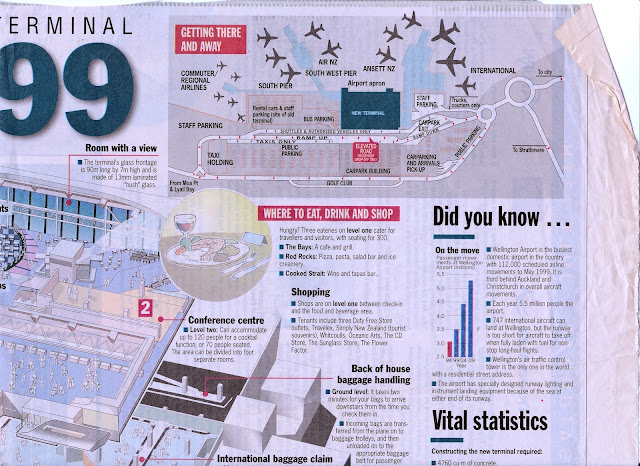The saga of Wellington's domestic airport terminal was one from the 1960s through to the end of the 1990s, and one that more recent generations know not of, but it was the embarrassment of the 1970s and 1980s for Wellington in the way that water infrastructure is looking like in the mid 2020s.
When Wellington Airport was opened in 1959, its (then only) terminal was a temporary building, having been a De Havilland aircraft factory from the 1920s. It has a range of characteristics that became infamous over the years. It would leak, it was draft ridden and in winter, cold. All aircraft were boarded using steps as entrance onto the tarmac was at ground level. In 1977 a new international terminal was built adjacent, as part of a plan to rebuild the whole terminal, but as it was a joint central/local government venture, there was no agreement on which entities would pay how much to pay for new capital investment. The international terminal served on average one or two flights a day at the most, and only to Australia. It wasn't until Ansett New Zealand emerged on the scene in 1987, intending to build its own separate new terminal (adjacent to international), that the old terminal got significantly refurbished, at the cost of Air NZ, keen to not be seen to have a second-rate terminal. It introduced airbridges, carpet, a lounge and improved the lighting and heating considerably.
However, the present day terminal emerged as a result of reforms starting in 1988 to corporatise and subsequently in 1998 part privatise the airport, so that it could operate as a business, borrow against landing charges and revenue raised from airlines, retail concessions and parking. Political arguments and finger pointing between central and local government ended immediately, as it was clear the airport could raise the finance and pay for a new terminal itself.
In 1999 the new terminal opened, integrating the international and Ansett buildings into one, and is the terminal known today.
Below is a series of clippings highlighting some of the moments in recent history surrounding the debate over replacing the terminal. I have a great deal more of this in my files that I have yet to dig out, so apologies for the haphazard nature of it...


The "Tin Shed Report" was a multipart series of articles in the Evening Post in 1985 questioning why there has been no progress on a new terminal. The first was the Managing Director of Challenge Properties (which would later merge with Fletchers to become Fletcher Challenge) proposing that it be a property development that it could lead, but local politicians thought its proposals were "unrealistic". The second article was the then WCC Design Engineer discussing the Challenge plan, including plans for commuter airlines to use the international terminal check-in (which was underutilised with only one or two flights a day). The third article was then Miramar electorate MP, Labour's Peter Neilson describing how the Council had prioritised the international terminal and then a runway extension over the domestic terminal replacement. WCC had called for the Government to fund its proposed runway extension as a priority, but the Government had rejected it (the local pressure at the time was due to Air NZ having dropped international flights from Wellington, as it had disposed of its McDonnell Douglas DC-8 aircraft and neither DC-10s nor Boeing 747-200s could operate
The then Lange Government had proposed that funding for a new terminal would be split evenly between Central Government and WCC, and was dependent on WCC accepting a more corporate structure for Wellington Airport (within three years the Government corporatised the airport, along with corporatisation of multiple airports around the country). At the time the concern was that WCC was delaying progress in agreeing on a new corporate structure.
 |
| 2 October 1985 Wellington airport terminal |
This truncated part of the editorial in 1985 had the Evening Post view of the time, which was that WCC wanted Wellington to be a "special case" that should get full government funding for a new terminal, which was not the government's position at the time.
 |
14 October 1994 - success of Wellington Airport company
|
The corporatisation of Wellington Airport was reported by the Evening Post to be a success, with a modest profit. Note at the time it was 66% owned by the Crown and 33% by Wellington City Council. The editorial notes some would say "who would want to buy it" if it were privatised, given constraints on its location. It noted the airport company has increased landing fees, increased income from retail concessions and parking, and cut spending. It notes new airport terminals will be built in four years. The editorial indicates if more airlines are to come to Wellington, the airport has to improve.
 |
| Cook Strait News 25 July 1994 |
Cook Strait News was a local eastern suburbs newspaper in Wellington. This ad from the airport company reports on its twenty-year masterplan depicting visually how it intends to use its land. Perhaps the most notable part that did not proceed, is bridging over the Cobham Drive end of the runway.
On the eve of the opening of the new terminal in June 1999, the Evening Post produced this two page cutaway of the terminal, with some history and statistics. By this time Wellington International Airport Limited was 66% privately owned (Wellington City Council retains a 33% shareholding). It would be fair to say, the transformation is unrecognisable compared to the "old tinshed"

















